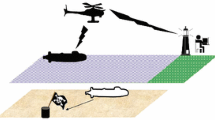Abstract
This paper describes a highly distributed fault-tolerant control system capable of compensating for deficiencies in system-level performance even when the cause of a fault cannot be explicitly identified. Developed for an autonomous underwater vehicle that must remain operational for several weeks without human intervention, this system must be capable of dealing with events that cannot be anticipated at design time. A unique aspect of this system is that it handles such events by attempting to “do whatever works” if it is unable to diagnose and correct specific faults. The software architecture used in this approach is applicable to a wide range of complex autonomous control applications.
Similar content being viewed by others
Explore related subjects
Discover the latest articles, news and stories from top researchers in related subjects.References
R.A. Brooks, “A robust layered control system for a mobile robot.” IEEE Journal of Robotics and Automation, RA-2(1), 1986.
J.L. Loch, “Design of a reflexive hierarchical control system for an autonomous underwater vehicle,” M.S. Thesis, MIT, 1989.
J.G. Bellingham, et al., “Keeping layered control simple.” in Proceedings of the Symposium on Autonomous Underwater Vehicle Technology, Washington, D.C., 1990, pp. 3–8.
R.P. Bonasso, “Underwater experiments with a reactive system for autonomous vehicles,” in Proceedings of the 9th National Conference on Artificial Intelligence, Anaheim, CA, 1991, pp. 794–800.
D.W. Payton, “An architecture for reflexive autonomous vehicle control,” in IEEE International Conference on Robotics and Automation, San Francisco, CA, 1986, pp. 1838–1845.
R. Arkin, “Motor schema based navigation for a mobile robot: An approach to programming by behavior,” in IEEE Conf. on Robotics and Automation, 1987, pp. 264–271.
R. Arkin, “Dynamic replanning for a mobile robot based on internal sensing,” in IEEE International Conference on Robotics and Automation, 1989, pp. 1416–1421.
P. Maes, “The dynamics of action selection,” in International Joint Conference on Artificial Intelligence, Detroit, MI, 1989, pp. 991–997.
M., Minsky, The Society of Mind, Simon and Schuster: NY, 1986.
R. Brooks, “The behavior language; User's guide,” Massachusetts Institute of Technology Artificial Intelligence Laboratory, A.I. Memo 1227, April, 1990.
E., Shortliffe, Computer-Based Medical Consultations: Mycin, American Elsevier: NY, 1976.
J. de Kleer, “Local methods of localizing faults in electronic circuits,” M.I.T., AI Memo 394, 1976.
J. de Kleer, “Diagnosis with behavioral modes,” in Eleventh International Joint Conference on Artificial Intelligence, Detroit, MI, 1989, pp. 1324–1330.
J., de, Kleer and B.C., Williams, “Diagnosing multiple faults,” Artificial Intelligence, 32, pp. 97–130, 1987.
M.R., Genesereth, “The use of design descriptions in automated diagnosis,” Artificial Intelligence, 24, pp. 411–436, 1984.
J.H. Hino, “Intelligent planning for a search and surveillance unmanned underwater vehicle (UUV),” in Seventh International Symposium on Unmanned Untethered Submersible Technology, University of New Hampshire, 1989.
J.K. Rosenblatt and D.W. Payton, “A fine-grained alternative to the subsumption architecture for mobile robot control,” in International Joint Conference on Neural Networks, Washington D.C., 1989, pp. 317–324.
D.W., Payton, “Internalized plans: A representation for action resources, Robotics and Autonomous Systems, 6(1), pp. 89–103, 1990.
D.W., Payton, J.K., Rosenblatt and D.M., Keirsey, “Plan guided reaction,” IEEE Transactions on Systems Man and Cybernetics, 20(6), pp. 1370–1382, 1990.
L.A., Zadeh, “Fuzzy sets,” Information Control, 8(3), pp. 338–353, 1965.
C.C., Lee, “Fuzzy logic in control systems: Fuzzy logic controller, part II,” IEEE Systems, Man, and Cybernetics, 20(2), pp. 419–435, 1990.
J., Hopfield and D., Tank, “Neural’ computation of decisions in optimization problems,” Biological Cybernetics, 52, pp. 141–152, 1985.
Author information
Authors and Affiliations
Rights and permissions
About this article
Cite this article
Payton, D.W., Keirsey, D., Kimble, D.M. et al. Do whatever works: A robust approach to fault-tolerant autonomous control. Appl Intell 2, 225–250 (1992). https://doi.org/10.1007/BF00119550
Received:
Revised:
Issue Date:
DOI: https://doi.org/10.1007/BF00119550




